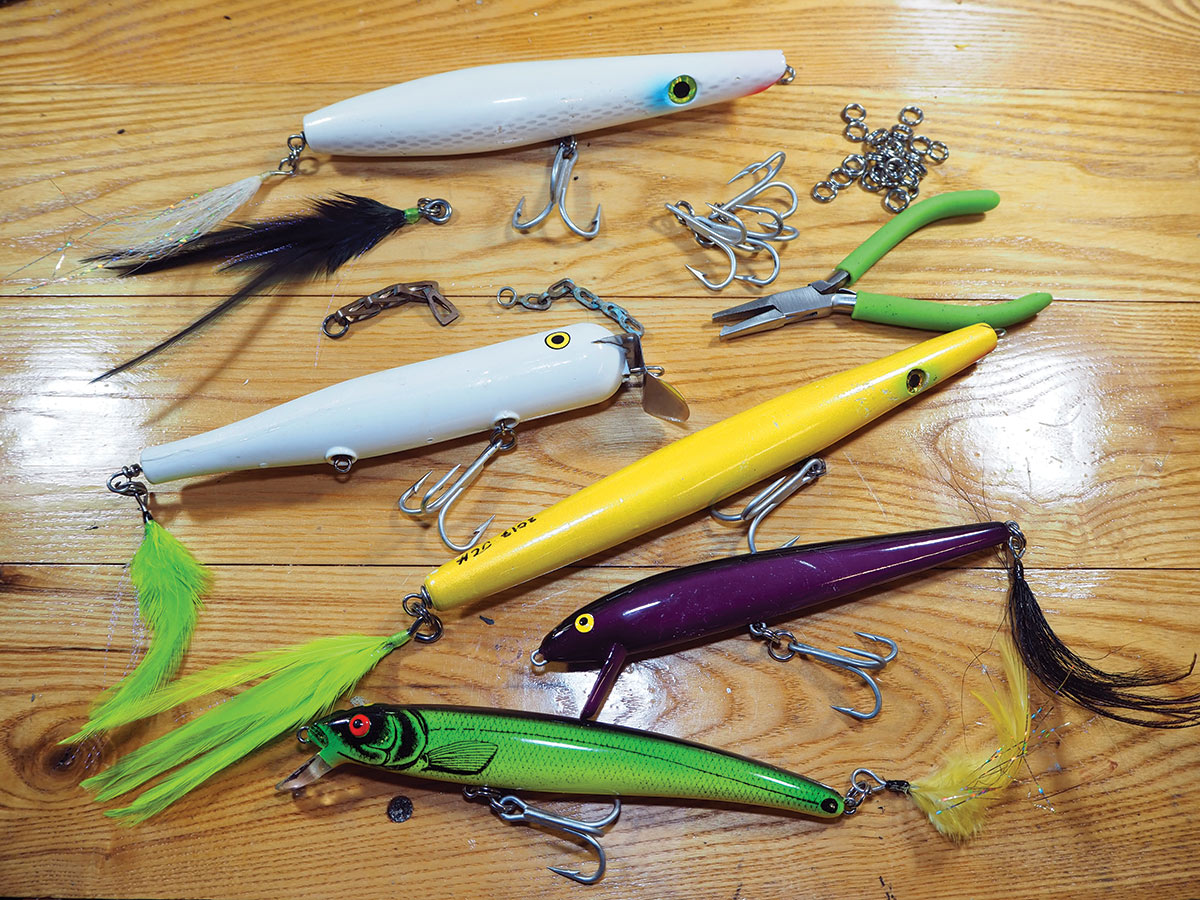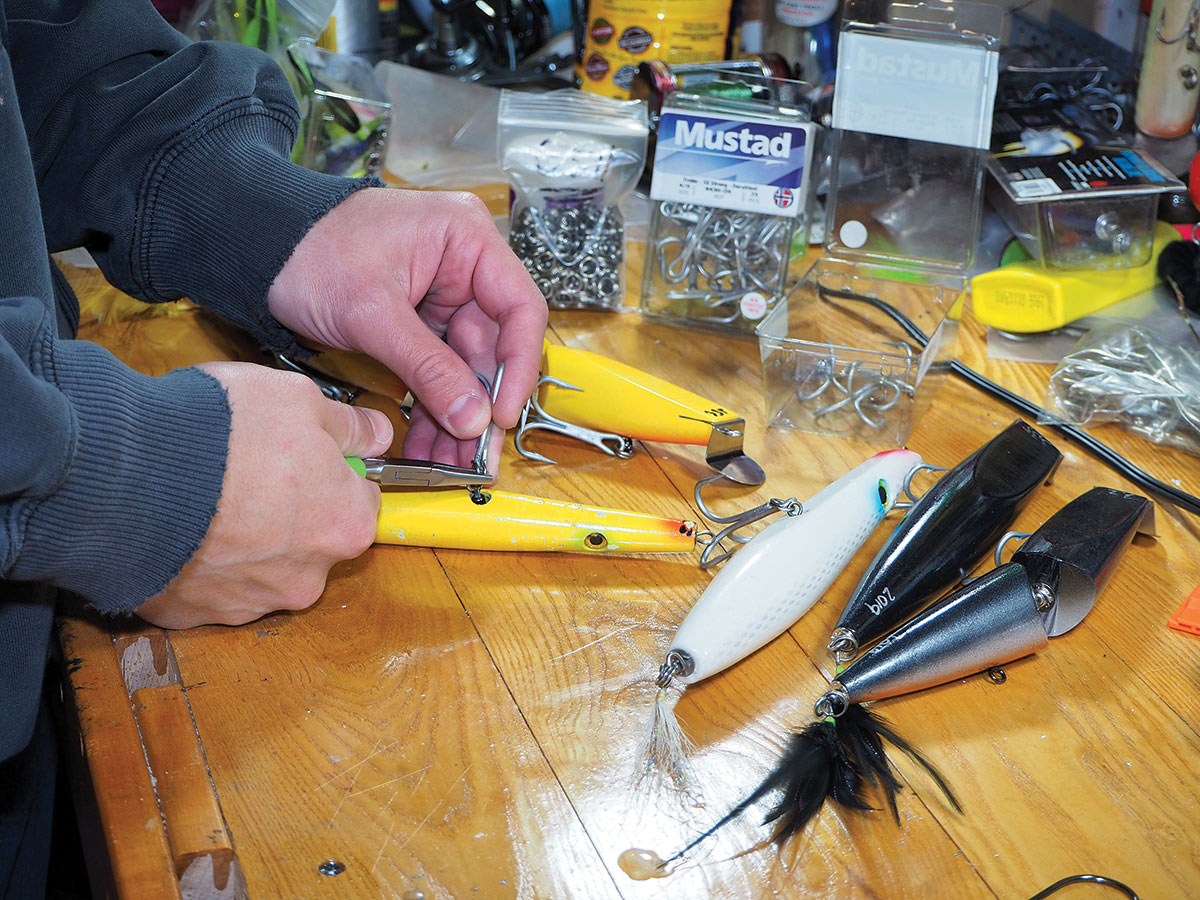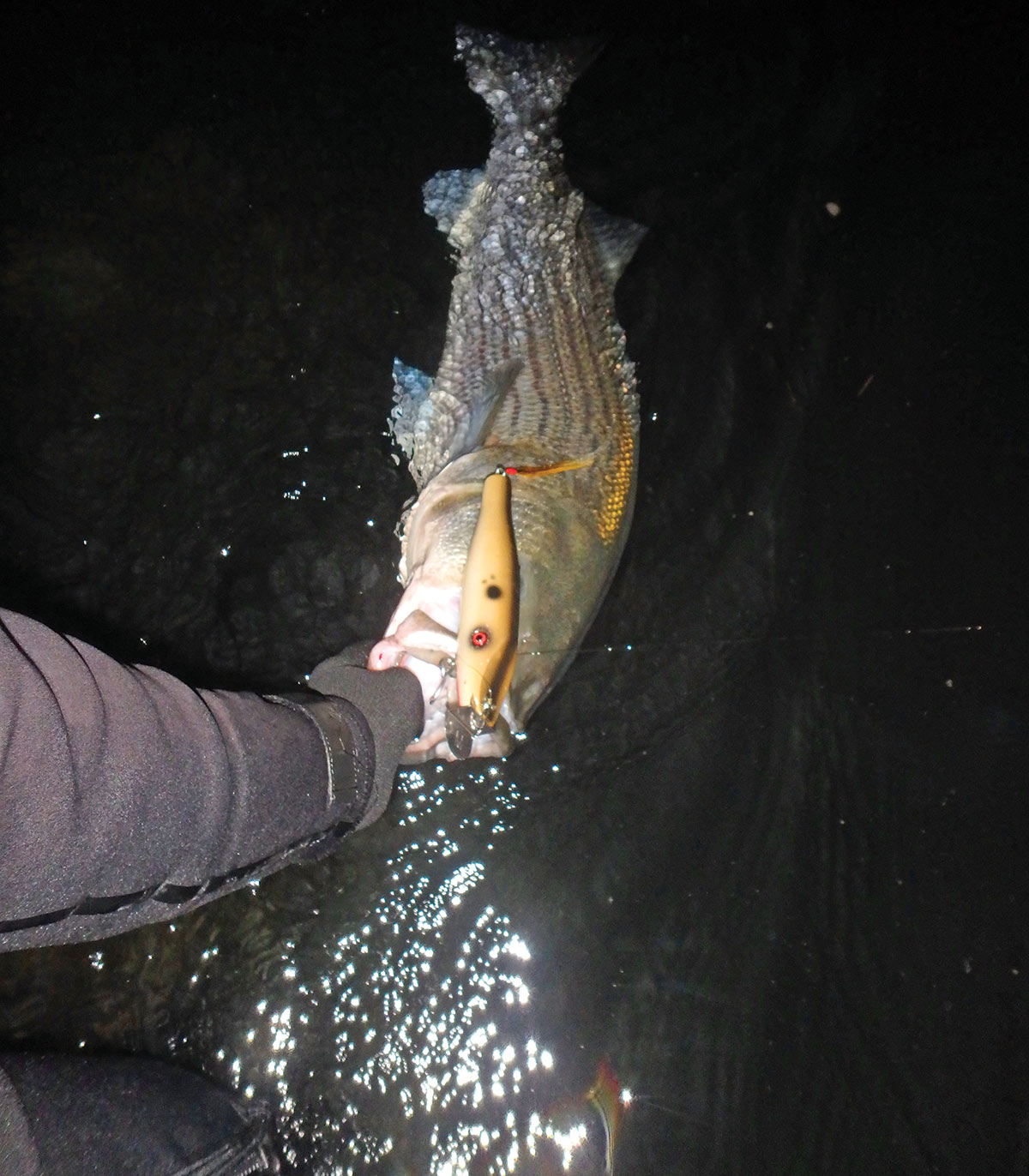
With a large portion of striped bass “harvest” attributed to dead discards, steps can be taken to lessen your impact without impeding success.
If you accept the numbers put out by the Atlantic States Marine Fisheries Commission (ASMFC) in regards to striped bass mortality, then the idea is that roughly half of all harvest of striped bass annually is attributed to dead discards, or release mortality. While I am not going to sit here today and debate the data, I am of the mindset that even if it’s off by a few percentage points either way, then it amounts to what I’d consider a lot of wasted fish and anything that we as anglers can do to lessen our impact in this way should be considered—short of ceasing fishing for striped bass altogether just yet.
Several years ago I made a concerted effort to begin fishing my artificial lures with fewer hook points on them. To some this concept might seem counter-productive if one’s end goal is to catch more fish, but I can say with the utmost confidence that my hit-to-landed-fish ratio has improved dramatically since making the change. Unfortunately it is not as simple as removing hooks, but to me the challenge of finding alternative ways to retain a plug’s intended balance without reducing its effectiveness has become an exciting and rewarding challenge if not somewhat of an obsession.
My journey with using a single treble hook began sometime in the 2014 season when my fishing partner, Jay Hanecak, began building plugs. First off the lathe was an 8-inch needlefish, and we quickly learned that the plug swam much better when outfitted with a single 4/0 treble on the belly swivel and a dressed flag on the tail. After being put to shame on several outings by Jay’s single-treble plugs, I began modifying all of my needlefish in this manner. From there I started working with the rest of my plugs to eliminate the tail or second belly hook, and it has become somewhat of a joke between the two of us as to the lengths to which I will go to achieve a productive, single-treble plug. Steal a peak into my plug bin or surf bag and you’ll now see that all of my plugs have a tail flag of some sort and hardly any of them carries a second hook. From 3-inch stubby needlefish to 7-inch Red Fins to large pencil poppers to 10-inch needlefish and everything in-between, they can all be successfully fished with a single treble hook so long as you are willing to put in a little work to figure out what rigging works best.
Now entering my sixth season of commitment to this modification, I have experienced a lot of positives and negatives along the way. I was somewhat hesitant about putting this concept to paper as I feel the extensive work that I have put into it should not simply be handed over to the masses. I have spent many hours at my local marina casting, testing, re-rigging and re-testing different configurations of hooks, tails and lures before heading out into the surf with them, but ultimately I feel that there are so many benefits to both angler and fish that I simply cannot keep it to myself any longer. Here are some of my findings.
The Benefits
Beyond the obvious benefit of damaging a fish much less, the single treble is far safer on the angler. I no longer have to worry about a second hook flailing around when landing a fish, and the plug acts as a handle of sorts when landing. I hardly need to use a light to unhook a fish now, too, and have caught fish right under other guys’ noses without them even knowing I was having success. This can be very helpful along an open, expansive beach where you can see a light going on and off from a great distance.

The single treble hook affords a much more secure connection to the fish. I lose very, very few fish with a single treble as the fish can no longer get leverage and pop a hook out. I also hook very few fish outside the mouth as it’s usually the second hook that snags a fish’s eye, cheek or head.
Despite what one might think by eliminating one or more of the treble hooks, I actually miss very few fish with the single treble. When using two treble hooks I found that the second hook was very seldom the primary point of contact. When a fish was landed and the tail hook was the only one connected to the fish, 99 percent of the time I could find where the front hook had been attached to the fish and tore free.
Rigging Up

In some cases fishing a plug with a single treble is as simple as removing all other hooks, but in most cases it requires some tinkering in order to retain optimum casting, swimming and fish-hooking performance. To begin with, you generally want to upsize the treble by at least one size. I also use a split ring on almost all of my plugs. This eases not only changing out hooks when needed but also drops the hook points a hair further back towards the center of the plug. While striped bass do generally seem to strike for the head of a bait, any time that you can position the hook closer to a lure’s center point the odds are better you’ll hook more fish.
Tail flags can balance a plug on the cast and swim depending on what is used, and they make for a more appealing presentation with an undulating bunch of feathers or bucktail hanging off the back of the plug. On plugs where weight is not needed, I simply use the same wire as the through wire to make my tail flags. However, when more weight is needed on the tail I use very large stainless steel siwash hooks (size 9/0) and cut the hook off right at the bend. You can also wrap solder or lead onto a piece of wire or over the tail wrap to add more weight. Another option is the chain often used on eelskin plugs, and this works quite well when a dressed tail flag is not needed or wanted. If you make your own plugs, or if you like to tinker, you can drill out the tail of a wooden lure and add heavier or additional tail weights, or you can drill small holes into a plug and pour lead right into the wood. On plastic plugs, oftentimes loading them, something done quite a bit with Red Fins for example, can be enough to balance the cast and swim. The options are really only limited by your creativity and drive.
When Doesn’t It Work?
To date there is no scenario where I have found that a single treble hook could not be successfully used. This doesn’t mean that you can blindly remove hooks from your plugs as noted earlier. I still strongly urge you to spend some time testing your modified plugs ahead of time, but this is something that you should be doing with each and every lure you have anyway. Wood is inconsistent by nature, and even mass-produced plastic plugs do not have the same consistency that manufacturers might have you believe. Go weigh your unrigged plugs and you’ll often find that otherwise identical lures can actually vary greatly.
One thing to consider when switching to a single treble hook is in regards to fishing surface plugs like the classic Danny swimmer. When all of the hook weight is centered on the front swivel, as opposed to spread evenly between a pair of swivels, it can sometimes be difficult to keep the lure swimming on top unless you play with the line tie or use something to balance the tail and keep it level on the retrieve. That balance can be achieved most easily by the use of a heavier tail flag (cut large siwash hook) or by drilling out and adding tail weight. Again, however, such extreme modifications as this must require subsequent testing to ensure the casting and swimming properties of the lure are not ruined—make these changes at your own risk.
What About Single In-line Hooks?
Several years ago I wrote about the use of single in-line hooks on plugs (Modifications That Matter, May 2015). I will not fully rehash the details of the article, but I still use them quite frequently in certain scenarios. However, I have found that single inline hooks do not work well with swivel hangers and I only use them on lures with solid hangers (like a Red Fin, Bomber Long-A, Yo-Zuri LC Minnow, etc.). What I found was that the single in-line hook, when used on a swivel belly hanger, would cause the hook to rest up along the underside of the lure and there was very little hook point protruding from the lure to catch a fish’s mouth. Due to this I would still get hits but I had a difficult time hooking a fish in this scenario. While I am fully aware that many anglers seeking pelagics and tropical species successfully use these hooks in conjunction with swivels, my findings were not positive—your results, of course, may vary.
Why Not Just Crush the Barbs?
I have not gone to crushing barbs, but only because I hadn’t really considered it a necessity yet. In my eyes crushing a barb really only serves as a benefit when the goal is to ease removal from the user/angler or when removing hooks from outside the mouth of a fish. With a single treble it is rather rare to get a hook anywhere other than inside the intended mouth, and I want as solid a purchase as possible there. Really the only time I “foul hook” a bass nowadays is when fishing a deep diving metal lip at a certain spot where there is a ledge. I believe the bass lie below the ledge and hammer the plug as it comes over their heads, and every so often when there is a very aggressive feed with many large fish around I will land a bass with the single treble buried square in their forehead. It’s quite the fight to land a fish in this manner and only happens with bass over 30 pounds at this spot—go figure!




